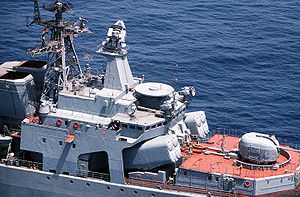- Metel Anti-Ship Complex
-
RPK-3 Metel
(NATO reporting name: SS-N-14 'Silex')
Two SS-N-14 launchers on a Udaloy class destroyer DDG-659.Type Anti-submarine/ship rocket Place of origin Soviet Union Service history In service 1969–current Used by Russia Production history Designed 1960s Specifications Weight 3,930 kg (8,700 lb) Length 7.2 m (24 ft) (85R missile) Warhead Various ASW torpedo or nuclear depth charge or ASW torpedo and 185 kg shaped charge warhead. Propellant solid fuel rocket Operational
range10 – 50 km (versus ship)
5 – 50 km (anti-sub with helicopter guidance)Maximum depth 20–500 metres Speed Mach 0.95, 290 m/s (650 mph) Launch
platformKresta II, Kara, Burevestnik 1 & 2, Udaloy I, Kirov Metel Anti-Ship Complex (Russian: противолодочный комплекс «Метель» 'Snowstorm'; NATO reporting name SS-N-14 Silex) is a Russian family of anti-submarine missiles and warheads. There are different anti-submarine variants ('Metel') for cruisers and frigates, and a later version with a shaped charge ('Rastrub') that can be used against shipping as well as submarines.
The missile carries an underslung anti-submarine torpedo which it drops immediately above the suspected position of a submarine. The torpedo then proceeds to search and then home in on the submarine. The missile has been in operational service since 1968, but is no longer in production; it was superseded by the RPK-2 Viyuga (SS-N-15 'Starfish').
Contents
Development
In the early 1960s the Soviet Union introduced the RBU-6000 and RBU-1000 anti-submarine rocket launchers, which worked on a similar principle to the Royal Navy's Hedgehog system of the Second World War, propelling small depth charges up to 5,800 metres (6,300 yd) from a ship. However this meant that a ship would still be in range of the submarine's torpedoes and missiles, and depth charges were less accurate than homing torpedoes. In 1963 the US Navy introduced ASROC, a missile that flew to the estimated position of the target submarine, and then dropped a torpedo into the water to destroy it. The SS-N-14 was the Soviet response.
In 1993, an upgraded version, designated YP-85, with a range of 250 km (130 nmi), was proposed for export.[1]
Design
The missile is based on the P-120 Malakhit (NATO: SS-N-9 'Siren') anti-shipping missile. The missile itself is radio command guided and is powered by a solid fuel rocket motor. The later 'Rastrub' models of the weapon were "universal" carrying a smaller torpedo, but with a 185 kg shaped charge warhead for use against ships. Rastrub missiles were deployed alongside the anti-submarine versions of the missile. In anti-submarine mode the missile flew at approximately 400 meters altitude, and where it was over the estimated position of the target submarine the missile was commanded to release the torpedo or depth charge. In anti-shipping mode the missile flies much lower, at approximately 15 meters.
Operational history
The URPK-3 entered service in 1969 on the Kresta II and Kara classes of cruisers.[1] The URPK-4 was introduced in 1973, and the anti-ship version URPK-5 Rastrub in 1976.[1] The URPK-4 has been used on the Burevestnik class frigate and the first batch of the Udaloy class destroyer; the Udaloy II carries the SS-N-15 'Starfish'. The system was installed on the Admiral Ushakov (ex-Kirov) but not on her sister ships.[1]
Of these the Krestas and all but two Karas have been retired, along with most of the Burevestniks and half the Udaloys; the Kirov appears to have been upgraded to the SS-N-16 'Stallion' at some point. 100 missiles are estimated to remain in service as of 2006[update].
Variants
- 60R - Original version armed with 5 kt nuclear depth charge
- 70R - Original version armed with AT-2U ASW torpedo
- 83R/URPK-3 Metel - Cruiser version of the missile using the guidance system from the SA-N-3 missile and the KT-106 launcher. Uses AT-1 torpedo (EA-45-70A)
- 84R/URPK-4 Metel-U, KT-106U launcher, used on Udaloy destroyers. Entered service 1973. Uses AT-2 (AT-2UM) torpedo (E53-72), which has either 100 kg HE warhead or possibly a 5 kt nuclear warhead.
- 85RU/URPK-5 Rastrub, KT-100U launcher. Entered service 1975. Carries either AT-2 (APR-2E ?) (E53-72) or UGMT-1 torpedo (E45-75A) and an additional anti-shipping warhead of 185 kg.
- 85RUS/URPK-5 Nuclear tipped version of the missile.
- YP-85 Proposed long-range version - see above.
Operators
External links
- Images of the missiles in the launch tubes at wonderland.org.nz
- Page about the SS-N-14 in Russian
- Manufacturer's page about the URK-5
Notes and references
- ^ a b c d "URPK-3/-4/-5 (SS-N-14 'Silex'/83R and 84R Metel, 85RU Rastrub)", Jane's Strategic Weapon Systems, 2008-09-10, http://www.janes.com/articles/Janes-Strategic-Weapon-Systems/URPK-345-SS-N14-Silex83R-and-84R-Metel-85RU-Rastrub-Russian-Federation.html, retrieved 2009-01-28
- Naval Institute Guide to World Naval Weapon Systems 1997 to 1998
- Jane's Underwater Warfare Systems 2006-2007
Categories:- Anti-submarine rockets and missiles
- Submarine-launched cruise missiles of Russia
- Cold War submarine-launched cruise missiles of the Soviet Union
- Weapons of Russia
- Guided missiles of the Soviet Union
- Nuclear weapons
Wikimedia Foundation. 2010.

